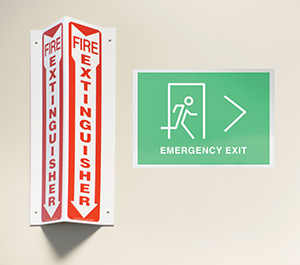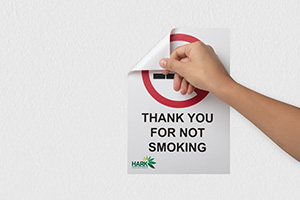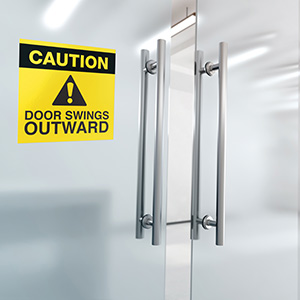Damage-free sign labels for the retail and restaurant industry can be removed cleanly from surfaces, dramatically reducing repair and repainting costs.
By Tina Huff
Throughout the retail and restaurant industries, signs are used everywhere from the front door and entrance, to restaurant guest and kitchen areas, to conference rooms and gift shops, to the routes and maps for emergency exits. Signs are used in many ways, whether informal, formal or mandated by law.
Permanent signs may not be an option when the information changes and needs to be updated. This can occur when policies and procedures change or during events, such as special sales.
 In such cases, temporary signs are used for directional navigation, identifying rooms and escape routes, as well as to provide warnings and precautions about various hazards. This is particularly important when any construction, remodeling, refurbishing or maintenance is occurring.
In such cases, temporary signs are used for directional navigation, identifying rooms and escape routes, as well as to provide warnings and precautions about various hazards. This is particularly important when any construction, remodeling, refurbishing or maintenance is occurring.
In such temporary situations, the traditional signage options for administrators and facility managers are limited. Because signs can be located in high-traffic areas and subjected to harsh cleansers, the sheets of paper, cardstock, sheet protectors, laminated sheets and posters used must not only present a professional image, but also stand up to the environment and even meet specific safety codes. Floor stands and easels can block aisles and foot traffic, and can even create trip hazards.
This is where the problem lies. Since many signs are not designed for high-traffic use, they may not look professional or be resistant to wear and tear from frequent touching, handling or the cleansers used in such environments. As a result, they are damaged easily and must be replaced frequently.
Many signs can also cause considerable damage to the underlying surfaces when taped, tacked, nailed or screwed to walls, glass or equipment, which can hasten the need for costly repair and repainting. Sign removal can also leave behind unsightly residual tape or adhesive. This is exacerbated when signs include information that is routinely changed or updated.
With repair, replacement and renewal one of the industry’s largest expenses, accounting for 8% to 12% of total revenue, wall painting and repair can represent a sizeable share of the cost. As such, the ideal solution would be signage that is easy to install, durable enough to endure heavy traffic, yet comes off easily when necessary, leaving no trace. This can significantly reduce the need for facility maintenance, freeing up resources for higher priority purposes.
Commercial-grade labels used as signage must be more durable than those used in a lower use area, but also should remove cleanly when they need to come down. The key to accomplishing this was developing an adhesive that holds well but can be removed when needed. Achieving that balance is harder than it sounds.
As a result, surface safe sign labels were developed — an exclusive, proprietary product specially engineered to stick securely yet remove cleanly without damage or residue to painted walls, doors, windows, furnishings, equipment and other interior surfaces.
These “labels used as signs” are made of durable, commercial-grade material that resists water, chemicals and even abrasion. Available in a variety of sizes, they print easily on standard laser or inkjet printers, opening a world of possibilities for custom, do-it-yourself signs.
Unlike standard office labels with a paper substrate, the topcoat of the commercial-grade sign labels is waterproof and chemical resistant, while its polyester substrate is a durable, scuff and tear-resistant film.
 These qualities are ideal for safety-related signage mandated by regulation or required by administrative policy. Whenever construction, remodeling or maintenance changes hotel or restaurant evacuation routes, for instance, management is responsible for posting signage for interim routes, which the removable surface safe sign labels can easily accommodate.
These qualities are ideal for safety-related signage mandated by regulation or required by administrative policy. Whenever construction, remodeling or maintenance changes hotel or restaurant evacuation routes, for instance, management is responsible for posting signage for interim routes, which the removable surface safe sign labels can easily accommodate.
Administrators, facility managers and safety officers will also want signs compliant with OSHA 1910.145 (Specifications for Accident Prevention Signs and Tags) and ANSI Z535.4 (Product Safety Signs and Labels).
Although standardized safety signs can be purchased out of catalogues, there is often a need to modify or customize mandated signage as conditions or formats change.
On-demand printing solutions, however, have traditionally required a large upfront investment of thousands of dollars, including a specialized sign and label printer, software, labels and ribbons.
In response, industry innovators have developed a simplified, flexible approach using standard laser and ink jet printers. Some companies now offer free online Design and Print Software enables customizable printing utilizing a hundreds of templates for use in facilities, for events and for safety signage.
 Retail and restaurant staff can create and print their own informal, formal or compliant labels from pre-designed templates or create them from scratch. Most find the process intuitive, since it resembles creating an office document from pre-designed templates.
Retail and restaurant staff can create and print their own informal, formal or compliant labels from pre-designed templates or create them from scratch. Most find the process intuitive, since it resembles creating an office document from pre-designed templates.
The removable labels can be printed on demand in whenever they are needed, and will stick securely on every surface in stores and restaurants including paint, drywall, windows, wood, plastic and metal. Because they peel off cleanly without leaving any residue, they can even be reused too.
With the variety of signage used throughout the industry, the ability to conveniently print new sign labels in minutes and cleanly remove the old will go a long way toward keeping the whole hospitality community safely up to date and professional looking without the hassle, mess or cost.
— Tina Huff is the group product manager at Avery Products Corporation. She spearheads the development of innovative labeling and identification products for the workplace. For more information, visit www.Avery.com/signs.
